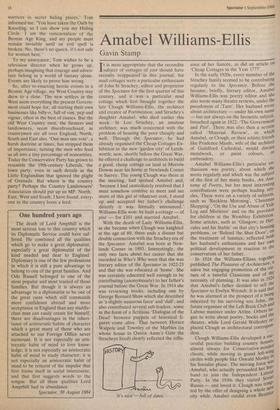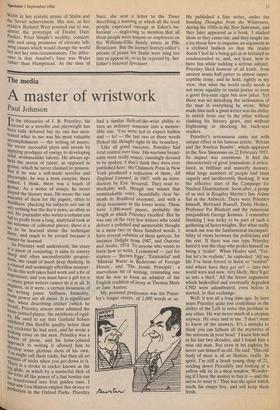Amabel Williams-Ellis
Gavin Stamp
It is most appropriate that the recondite subject of cottages of pise should have recently reappeared in this journal, for mud cottages were a particular enthusiasm of John St Strachey, editor and proprietor of the Spectator for the first quarter of this century, and it was a particular mud cottage which first brought together the late Clough Williams-Ellis, the architect and creator of Portmeirion, and Strachey's daughter Amabel, who died earlier this week. St Loe Strachey, an amateur architect, was much concerned with the problem of housing the poor cheaply and well. Through the Spectator, he had already organised the Cheap Cottages Ex- hibition in the new 'garden city' of Letch- worth; now, shortly before the Great War, he offered a challenge to architects to build a good, cheap cottage on land at Merrow Downs near his home at Newlands Corner in Surrey. The young Clough was there at the meeting, had spotted Amabel and, 'because I had immediately resolved that I must somehow contrive to meet and see more of this girl at whatever cost, I stood up and accepted her father's challenge directly it was formally announced.' Williams-Ellis won: he built a cottage — of pise — for £101 and married Amabel.
With the death of Lady Williams-Ellis, as she became when Clough was knighted at the age of 89, there ends a distant but double connection with the Strachey era of the Spectator. Amabel was born at New- lands Corner in 1893. Interestingly, the only two facts about her career that she recorded in Who's Who were that she was literary editor of the Spectator in 1922-23 and that she was educated at 'home'. She was certainly educated well enough to be contributing (anonymously) to her father's journal before the Great War. In 1914 she was reviewing books, including one by George Bernard Shaw which she described as 'a slightly nauseous farce' and 'dull', and also contributed several sub-leaders, some in the form of a fictitious 'Dialogue of the Dead' between puppets of historical fi- gures come alive. That between Horace Walpole and Townley of the Marbles (in whose house in Queen Anne's Gate the Stracheys lived) clearly reflected the influ- 'It's nice — full of dates.'
ence of her fiancée, as did an article on 'Cheap Cottages in the Year 1777'.
In the early 1920s, every member of the Strachey family seemed to be contributing regularly to the Spectator. Before she became, briefly, literary editor, Amabel Williams-Ellis was poetry editor and she also wrote many theatre reviews, under the pseudonym of :Tarn'. Her husband wrote about architecture — under his own name — but not always on the favourite subject, broached again in 1922: 'The Government and Pise'. There was also then a section called 'Material Review', in which Amabel, or Clough, or their artistic friends like Prudence Maufe, wife of the architect of Guildford Cathedral, would discuss metalwork, or paint colours, or embroidery.
Amabel Williams-Ellis's particular en- thusiasm was poetry, about which she wrote regularly and which was the subject of the first of her many books, An Alla- tomy of Poetry, but her most interesting contributions were perhaps leading arti- cles. These were on a variety of subjects, such as 'Reckless Motoring', 'Christmas Shopping', 'On the Use and Abuse of Yule Log and Mistletoe' and on the provision for children at the Wembley Exhibition. Some articles, such as 'Glasgow; or Her- cules and his Stable' on that city's housing problems, or 'Behind the Shut Door', 011 the treatment of lunatics, reflected both her husband's enthusiasms and her 430 political development in reaction to the conservatism of her father. In 1924 the Williams-Ellises together published The Pleasures of Architecture, a naive but engaging promotion of the tues of a tasteful Classicism and of til„e, necessity of planning. It was also in 194' that Amabel's father decided to sell the Spectator to Evelyn Wrench. It is said that he was alarmed at the prospect of it being inherited by his surviving son John, the, future organiser of the Left Book Club an° Labour minister under Attlee. Others be- gan to write about poetry, books and the theatre, while Lord Gerald Wellesley re- placed Clough as architectural correspon- dent. Clough Williams-Ellis developed a sue- cessful practice building country housesci almost always for Conservative-m"nde clients, while moving in grand left-W11 circles with people like Oswald MosleY 1! his Socialist phase. The moving force v/11' Amabel, who actually persuaded her bus; band to join the Independent Lab0,t1,. Party. In the 1930s they visited Sovic' Russia — and loved it. Clough was tell; ted by the offer of designing a whole ne c city while Amabel outdid even Beatric
Webb in her ecstatic praise of Stalin and the Soviet achievement. She was, as her relative Richard West pointed out to me, almost the prototype of Deidre Dutt- Pauker, Peter Simple's wealthy, comfort- able and smug promoter of extreme left- wing causes which would change the world but not her own circumstances. The differ- ence is that Amabel's base was Wales rather than Hampstead. At the time of
Suez, she sent a letter to the Times describing a meeting at which all the local people expressed outrage at Eden's be- haviour — neglecting to mention that all these people were tenants or employees on the Williams-Ellis family estate at Plas Brondanw. But the former literary editor's paeans of praise for Stalin were sung too late to appear in, or to be rejected by, her father's beloved Spectator.











































 Previous page
Previous page